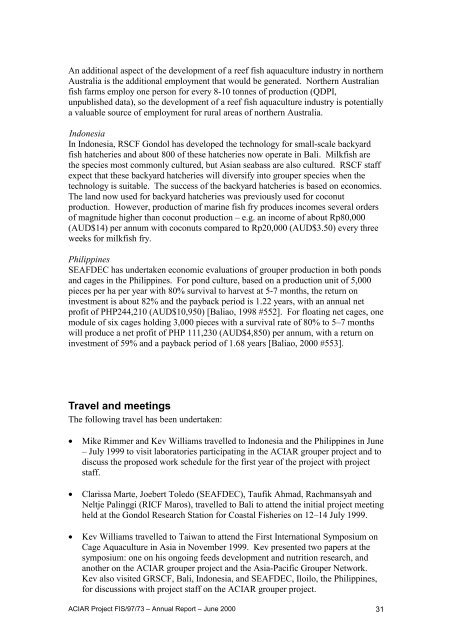ACIAR Project FIS/97/73 - Library - Network of Aquaculture Centres ...
ACIAR Project FIS/97/73 - Library - Network of Aquaculture Centres ...
ACIAR Project FIS/97/73 - Library - Network of Aquaculture Centres ...
You also want an ePaper? Increase the reach of your titles
YUMPU automatically turns print PDFs into web optimized ePapers that Google loves.
An additional aspect <strong>of</strong> the development <strong>of</strong> a reef fish aquaculture industry in northernAustralia is the additional employment that would be generated. Northern Australianfish farms employ one person for every 8-10 tonnes <strong>of</strong> production (QDPI,unpublished data), so the development <strong>of</strong> a reef fish aquaculture industry is potentiallya valuable source <strong>of</strong> employment for rural areas <strong>of</strong> northern Australia.IndonesiaIn Indonesia, RSCF Gondol has developed the technology for small-scale backyardfish hatcheries and about 800 <strong>of</strong> these hatcheries now operate in Bali. Milkfish arethe species most commonly cultured, but Asian seabass are also cultured. RSCF staffexpect that these backyard hatcheries will diversify into grouper species when thetechnology is suitable. The success <strong>of</strong> the backyard hatcheries is based on economics.The land now used for backyard hatcheries was previously used for coconutproduction. However, production <strong>of</strong> marine fish fry produces incomes several orders<strong>of</strong> magnitude higher than coconut production – e.g. an income <strong>of</strong> about Rp80,000(AUD$14) per annum with coconuts compared to Rp20,000 (AUD$3.50) every threeweeks for milkfish fry.PhilippinesSEAFDEC has undertaken economic evaluations <strong>of</strong> grouper production in both pondsand cages in the Philippines. For pond culture, based on a production unit <strong>of</strong> 5,000pieces per ha per year with 80% survival to harvest at 5-7 months, the return oninvestment is about 82% and the payback period is 1.22 years, with an annual netpr<strong>of</strong>it <strong>of</strong> PHP244,210 (AUD$10,950) [Baliao, 1998 #552]. For floating net cages, onemodule <strong>of</strong> six cages holding 3,000 pieces with a survival rate <strong>of</strong> 80% to 5–7 monthswill produce a net pr<strong>of</strong>it <strong>of</strong> PHP 111,230 (AUD$4,850) per annum, with a return oninvestment <strong>of</strong> 59% and a payback period <strong>of</strong> 1.68 years [Baliao, 2000 #553].Travel and meetingsThe following travel has been undertaken:• Mike Rimmer and Kev Williams travelled to Indonesia and the Philippines in June– July 1999 to visit laboratories participating in the <strong>ACIAR</strong> grouper project and todiscuss the proposed work schedule for the first year <strong>of</strong> the project with projectstaff.• Clarissa Marte, Joebert Toledo (SEAFDEC), Taufik Ahmad, Rachmansyah andNeltje Palinggi (RICF Maros), travelled to Bali to attend the initial project meetingheld at the Gondol Research Station for Coastal Fisheries on 12–14 July 1999.• Kev Williams travelled to Taiwan to attend the First International Symposium onCage <strong>Aquaculture</strong> in Asia in November 1999. Kev presented two papers at thesymposium: one on his ongoing feeds development and nutrition research, andanother on the <strong>ACIAR</strong> grouper project and the Asia-Pacific Grouper <strong>Network</strong>.Kev also visited GRSCF, Bali, Indonesia, and SEAFDEC, Iloilo, the Philippines,for discussions with project staff on the <strong>ACIAR</strong> grouper project.<strong>ACIAR</strong> <strong>Project</strong> <strong>FIS</strong>/<strong>97</strong>/<strong>73</strong> – Annual Report – June 2000 31
















